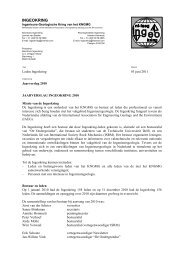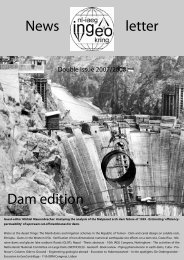environment
environment
environment
- No tags were found...
You also want an ePaper? Increase the reach of your titles
YUMPU automatically turns print PDFs into web optimized ePapers that Google loves.
Vol. 11 No. 1 2004<br />
Figure 3: The geological profile along a vertical cross-section based upon information from soundings and borings.<br />
isolated area. So, there is less dilution and far less time<br />
available for biodegradation in the shallow aquifer. The<br />
result is a higher emission to the deeper aquifer for the<br />
current situation. Therefore, remedial measures need to<br />
address this aspect in the near future in order to reduce<br />
Figure 4: Back tracing along flow lines. The flow lines<br />
(light blue lines) end at the depth of the observation<br />
well at which the concentration level exceeds more<br />
than five times the Dutch intervention level for<br />
cyanide. The flow line starts at the groundwater table<br />
where replenishment with infiltrating rainwater takes<br />
place.<br />
this emission.<br />
Conclusions<br />
The geological origin of the investigated location of<br />
the former Gasworks facility in The Hague is a key factor<br />
in assessing the risk of contaminant migration. The<br />
presence of a continuous layer consisting of peat and<br />
clay is dominant not only in the local groundwater flow<br />
pattern. Especially the peat layer also is a major source<br />
of carbon and of nutrients necessary for microbiological<br />
activity. The result of this activity is biodegradation or<br />
transformation of contaminants. A disadvantage of the<br />
peat layer is consolidation when extraction of<br />
groundwater is involved. Therefore, it is important to<br />
gain a thorough knowledge of the geological origin of a<br />
site in order to be able to construct a reliable Conceptual<br />
Site model. Subsequently, soundings, borings and other<br />
measurements are used to verify the CSM.<br />
Literature<br />
Clement, T.P. 1997, RT3D - A Modular Computer Code<br />
for Simulating Reactive Multi-Species Transport in 3-<br />
Dimensional Groundwater Aquifers. Pacific Northwest<br />
National Laboratory, Richland, Washington. PNNL-<br />
11720.<br />
7




